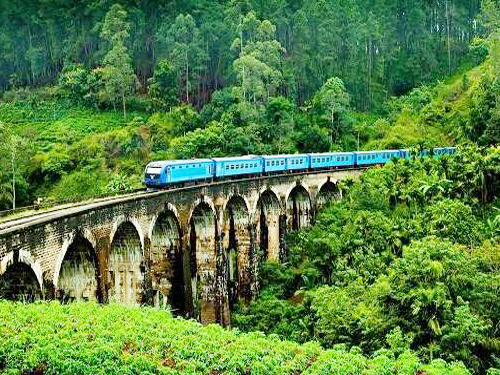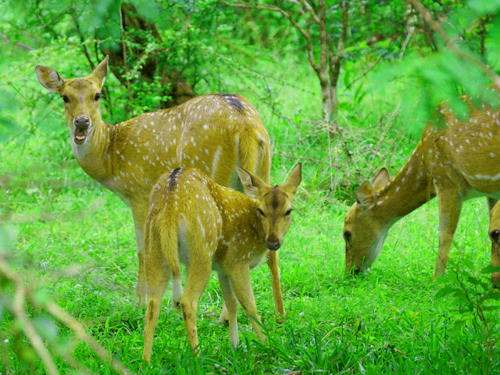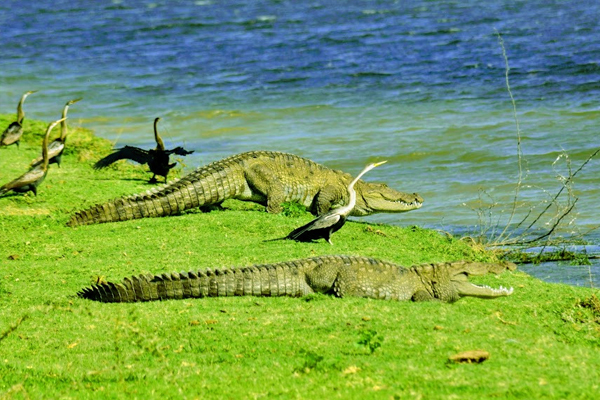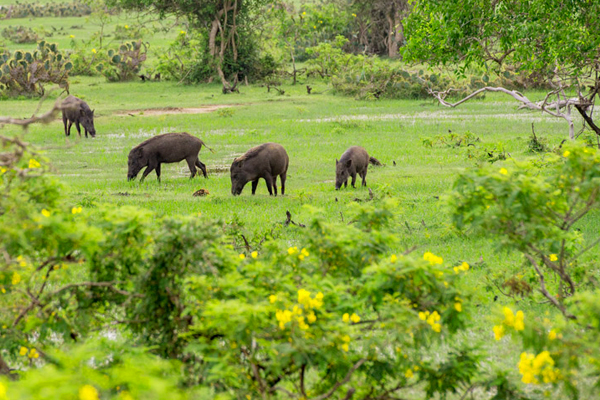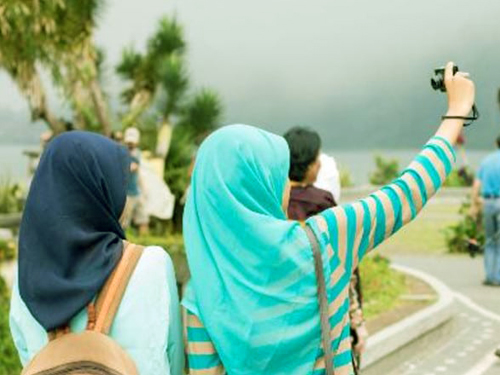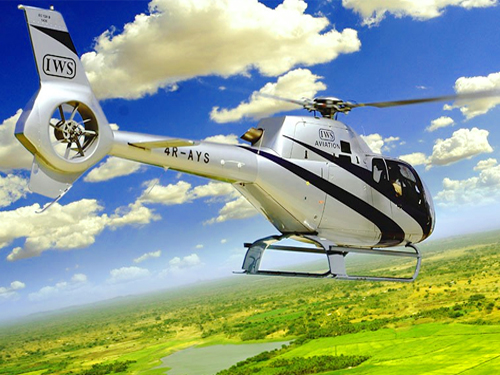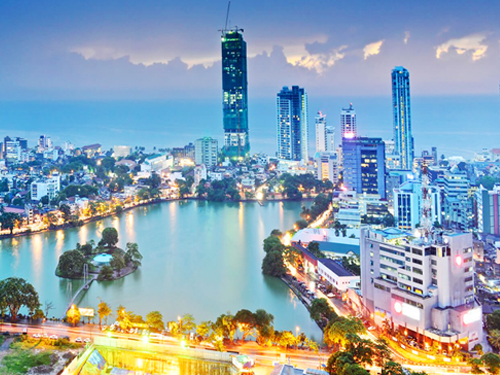Bundala in Sri Lanka
The rich biodiversity of its bird and plant species has earned the national park the title of UNESCO's fourth biosphere reserve in Sri Lanka. Biosphere reserves can be described as "learning places for sustainable growth", where ecological systems can still be maintained through conflict prevention and sustainable management.
This area is mainly covered with hornblende - biotite gneiss from the eastern Vijayan sequence. The average relative humidity in the area is 80%. Five shallow brackish lagoons are part of the national park, with salt pans in three. Bundala lagoon, which covers 520 hectares (2.25 mi), Embilikala Lagoon covering 430 hectares (1.75 mi), Malala Lagoon covering 650 hectares (2.25 mi), Malala Lagoon covering 650 hectares (3.25 mi), Koholankala lagoon covering 390 hectares (1.75 mi), Mahalewaya covering 260 hectares (1.25 mi)). Nearly all of the Koholankala or Mahalewaya areas are used for salt production. The climate is tropical monsoonal with an average annual temperature of 27 degrees Celsius (81 degrees F). The annual rainfall is between 900-1300 millimetres (35-51 inches), and the dry season lasts from May through September. The park's elevation is between 10 metres (33.3 ft) and sea level. 2004 Indian Ocean tsunami caused significant damage to the park. The park was protected by sand dunes and suffered very little damage.
On 5/12/1969, the area was designated a wildlife sanctuary and made a national park. It covers 6,216 hectares (24.00 sq mi) in area. The original park's area was reduced to 3,698 ha (14.28 sq miles) after the park was regazetted. Bundala was the first Ramsar wetland in Sri Lanka, being designated as such in 1991. UNESCO declared Bundala a Man and Biosphere Reserve in 2005. A Bundala area covering 3,339.38 ha (12.8934 sq mi), was designated the Wilmanna Sanctuary in January 2006.
Bundala National Park, (BNP), which makes up the Core Zone, has four brackish water lagoons that are rich with wetland species. This includes 2 species of Crocodiles. There are approximately 230 species of bird, both native and migrant, in the BBR.
The BBR has mapped 10 habitat types. These include the beach/seashore and sand dunes; scrubland; dry mixed evergreen forest/thorn/arid zone forest; salt marsh/lagoon marh vegetation; seasonal waterbodies (freshwater); paddy, home gardens, and the wetlands/waterbodies. You will also find mangroves in small areas, as well as some freshwater aquatic vegetation in seasonal water bodies and tanks.
Ramsar sites are designated as wetlands to be international important under the RAMSAR Convention. Also known as "The Convention on Wetlands", this intergovernmental environmental treaty was established by UNESCO in 1971. The Convention was signed in Ramsar, Iran in 1971. It entered into force in 1975. The Ramsar Convention's main purposes are to stop the loss of wetlands worldwide and to preserve, through wise management and use, the ones that remain. There are currently 2,437 Ramsar sites in the world that protect 254,691,993 ha (629,357.620 acres) and 171 national governments participating.
Bundala lagoons in Sri Lanka were declared the first Ramsar site with international significance for migratory birds. Bundala Wetlands was designated a Ramsar site under the sequence number 487 on 15 June 1990. Bundala safari Park, which is home to over 15,000 migratory shorebirds in southern Sri Lanka, is the most important site for wintering in this area. It also provides habitat for endangered and rare species of water birds. This makes it one of the best places for wildlife photography and bird watching tours in Sri Lanka.
Bundala is located in the Dry Zone. The average annual rainfall is between 900 mm and 1300 MM. There are two peak periods of rainfall in April-May and October-November. There is also an intervening dry period in May and September. The average annual temperature is 27 C. The relative humidity ranges from 76% to 81%. During the South-West or North-East monsoons, winds can reach speeds of 23 km/hour. (DWC)
The national park's ecological areas contain seven terrestrial habitat types as well as six wetland . The most abundant plants are the dry thorny shrubs, herbs and ferns. The park is home to 383 species of plants belonging to 90 families. Water Hyacinth and Water Lilies are common in the streams and marshes. Typha Angustifolia reed bed is also found. Acacia scrubs, including Dichrostachys cinerea and Randia dumetorum as well as Ziziphus sp., Gymnosporia Emarginata, Carissa Spinarum, Capparis Zeylanica, and Cassia species, make up the majority of the vegetation. Bauhinia racemosa and Salvadora persica are the main trees in the forest. The national park is home to many Halophyte species that thrive in its environment. Salicornia briata, and Halosarcia indica are two examples of salt-tolerant plants. Lumnitzera racemosa trees can be found in the Bundala lagoon's small patch of degraded mangrove. This is a rare type of forest in Sri Lanka.
A variety of vegetation types can be found in low-lying areas and lagoons, such as salt marsh, mangrove, and aquatic vegetation. Seven types of terrestrial vegetation/habitat (dry thorny scrubland and arid zones forests, sand dunes vegetation, gentle shore vegetation, arid area maritime grasslands/pastures and riverine forest, anomalous Mesquite shrublands) were identified by IUCN in a 2001 biodiversity survey (Bambaradeniya and al., 2001). (Reference: Biodiversity Baseline survey of DWC - Department of Wildlife Conservation Sri Lanka).
Bundala ecosystems include seven types of terrestrial habitat and six types of wetland. There are 383 species of plants in Bundala, belonging to 90 families. They are dominated by dry thorny and herb species, as well as acacia, acacia, and acacia. Blue-green algae, Hydrilla, and water lilies dominate the lagoons. Due to the unique Palu (Manilkara Hexandra) tree strip, the Bundala village's sand dunes are also worth a visit.
The lagoons have seen their water quality change due to the drainage of excess water from irrigation system and the release of sludge into Bundala lagoon. Two invasive alien plants, Prosopis juliflora (a weed) and Opuntia dillenii (a weed), have caused the destruction of wildlife habitats in the shrub forest and dunes. Uncontrolled livestock herds make it easy to spread Prosopis.
The Opuntia cactuses' seeds (known as kathupotak Sinhala) can be spread by macaque monkeys and other animals that eat them. People can also spread it by cutting down cactus and leaving the cuttings. The moth Cactoblastiscactorum has not been controlled. The large area they have covered will make manual removal difficult.
A turtle conservation project was launched, as well as an invasive alien plant eradication program that aims to eradicate Opuntia daillenii and Prosopis. Conservation measures include re-delineating the park's boundaries and expanding the boundaries to include northern scrubland, relocation of families living within the park, and a program to control the spread of invasive plants. Irrigation structures are also proposed to manage livestock grazing and stop water from flowing.
Bundala National Park has been designated an exceptional Important Bird Area within the South Indian and Sri Lankan wetlands. The national park has 324 species recorded of vertebrates, including 32 species fish, 15 species amphibians and 48 species reptiles. There are also 197 species birds and 32 species mammals. The invertebrates include 52 species of butterfly. Bundala's wetland habitats are home to about 100 species water birds, with half being migrants. Out of the 197 species of avifaunal birds, 58 are migratory. In 2005, the National Bird Ringing Programme (NBRP), was launched in Bundala in collaboration with the Department of Wildlife Conservation & Field Ornithology Group of Sri Lanka.
Bundala National park is home to 32 species of mammals, five are threatened. Bird enthusiasts will appreciate the rich bird life found in Bundala National Park's complex wetland system. There are 197 species, many of which are migratory waterfowl. A small number of Sri Lankan elephants, a recognized subspecies of their Asian counterpart, is found in Bundala. They are easy to spot in open habitat. Many visitors are lucky enough to spot a single elephant walking along the beaches.
The Park is home to Sri Lankan Leopards. Their food source is the many Sambar, Barking Deer and Spotted Deer. However, they are more difficult to spot than Yala. Bundala safaris can also be a great way to see the endemic Toque Macaque and Common Langur as well as Jackal, Jackal, Fishing Cats, Rusty Spotted Cats, Wild Boars, Wild Boars, Mouse Deers, Sambar Deer, Spotted Deer and Black Napped Hare.
The greater Flamingo Phoenicopterus Roseus is the highlight. It visits large flocks of more than 1,000 individuals from Rann at Kutch in India. Waterfowl (lesser whistling Duck Dendrocygna Javanica, garganey Ans querquedula), and cormorants (little Cormorant Phalacrocorax Niiger, Indian Cormorant P. fuscicollis), large birds (grey heron Ardea cinerea and black-headed ibis Threskiornis niger, Eurasian spoonbill Platalea leicorodia, Asian openbill Anastomus citans, Asian openbill Anastomus.oscitans), medium-sized waders(Tringa.spp. ), and small waders Charadrius spp. The other avifaunal species that are found in large flocks are the Ephippiorhynchus asiaticus, Leptoptilos javanicus and Fulica atra. The national park is home to rare birds such as the black-necked stork Ephippiorhynchus javanicus, Leptoptilos Javanicus, and Fulica atra, a lesser adjutant.
This National Park was designated an "Important Bird Area" within the South Indian and Sri Lankan wetlands. This park has been home to 197 species of birds. The wetland habitats are home to about 100 species, half of which are migrants. Out of the 197 species of avifaunal birds, 58 are migratory. Bundala National Park, which is home to the Greater Flamingo, is the last refuge for them. Large flocks of them can be seen here during migration. Here you can see large numbers of Estuarine crocodiles and Mugger Crocodiles.
The Estuarine Crocodile, which is the largest reptile, can grow to 7m in height and weigh up to 1,200 kg. Females reach a maximum length only 3m.
Two endemic species are the Yala Toad, Bufo atukoralei, and the Sri Lankakeelback (Xenochrophis Asperrimus), both found in Bundala National Park. The Park also contains the Common Monitor and Star Tortoise as well as Python, Rat Snakes, Cat Snakes, Whip Snakes, and endemic Flying Snakes. All five endangered species of sea turtles migrate to the adjacent seashore. Bundala is home to both Marsh and Estuarine Crocodiles, as well as Monitor Lizards and many other reptiles.
Five endangered sea turtle species are being raised in a breeding ground
Bundala's coastline is home to five species of turtles, including the olive ridley (green turtle), hawksbill (loggerhead), leatherback, and hawksbill. These endangered species have been protected by the Department of Wildlife Conservation. To help them nest and breed their eggs, a turtle hatchery was established. The hatchlings are released into the ocean after their hatching season, which varies depending on each turtle.
FAQs
Is it worth going on a safari in Bundala National Park?
Yes. If you are staying on the southern coast, it is recommended that you experience Bundala National Parc's jeep safari. Bundala National Park is an excellent choice if you're on a wildlife photography or bird watching tour.
When is the best time for a Bundala National Park Safari?
Although Bundala National park can be visited all year round, December is the best month to bird, while August and April are great seasons for wildlife safaris.
What is the Bundala National park Entrance Fee?
- The foreign adult rate is 7,500LKR including taxes/service charges
- Foreign Children aged 6 - 12 Year rate is 3,750LKR
- Foreign children 0-6 years old are free of charge, provided their parents accompany them.
What is the price of a safari jeep in Bundala National Park, India?
- Half-day safari Jeep in Bundala National Park will cost approximately 40 to 45 dollars
- Bundala National Parc, 85-90 $ per day.
- For a smooth safari in a jeep, contact your Sri Lankan travel agent.
- This price is based upon 2022 May rates. New prices could vary due to fuel increases / taxes, etc.
How to get to Bundala National Park?
From Colombo, there are three regular routes: along the coast via Galle Matara Tangalle, Hambantota (approximately 160miles/256km), and via Ratnapura Pelmadulla Embilipitiya Hambantota (345km/152 miles). Through the Southern Expressway: Exit the expressway at Galle, and go past Matara/Tangalle. Travel time from Colombo to Colombo is 3-4 hours. You can also travel by Air Taxi from Colombo (Peliyagoda), landing in Hambantota. You can either drive or fly from Hambantota to Bundala National park. Take off from Ratmalana or Bandaranaike Airport and land at Bundala. From there, you can drive to the Park.
What currency can I use to pay Bundala National Park Entry Fees in USD?
You must pay in Sri Lankan Rupees. International currencies are not accepted at Bundala National Parcs of Sri Lanka.
Can I purchase Bundala National Park Entry Ticket online?
Yes, you can book your Bundala National Park tickets online, starting April 2022.
Is it safe for me to go on safari in Bundala National park?
You cannot give a yes or no answer because you are entering the zone of wild untamed animals. The Department of Wildlife Conservation (DWC), has committed to the safety of visitors. The safari jeep driver code of conduct/rules is in place. You must ensure your safety and remain inside the safari jeep. Avoid unnecessary behavior like shouting, feeding, selfies or high-speed driving.
Can I rent an air-conditioned safari jeep in Bundala National park?
Yes, but it is subject to availability. It is important to notify your travel agent in Sri Lanka before you go.
Can I do night safari in Bundala National Park?
It is not allowed to conduct night safaris or infrared drives at Bundala National Park Sri Lanka.
Do I have permission to wander around the national parks?
Not at all. You are not allowed down the Jeep.
What happens if I have special dietary needs?
Ceylon Travel Dream usually plans meals well in advance and organize accordingly.
Individual travelers should consult with their Travel Agent in Sri Lanka if you have any questions.
How far in advance must I book Bundala National Park Safaris?
Individual travelers do not require advance booking. You can get the ticket at the gate. If you are traveling with a Travel Company, however, there is no need to book in advance. It is better to inform them in advance so they can reserve the safari tracker and safari jeep, and any other logistic arrangements.
Which time is best to see wildlife?
The best times to see wildlife are in the morning or afternoon before sunset.
Safari at Bundala
Three safari options are available to guests.
- Morning Safari (6.00 am)
- Afternoon Safari (2.30pm)
- Full day Safari
For a unique safari experience, the safari would be led by an experienced guide in specially modified comfortable Jeeps. The tour can be customized to suit the needs of guests.

 Safe Travels
Safe Travels Français
Français Deutsch
Deutsch עִברִית
עִברִית Italiano
Italiano Nederlands
Nederlands Polski
Polski Pусский
Pусский Español
Español



